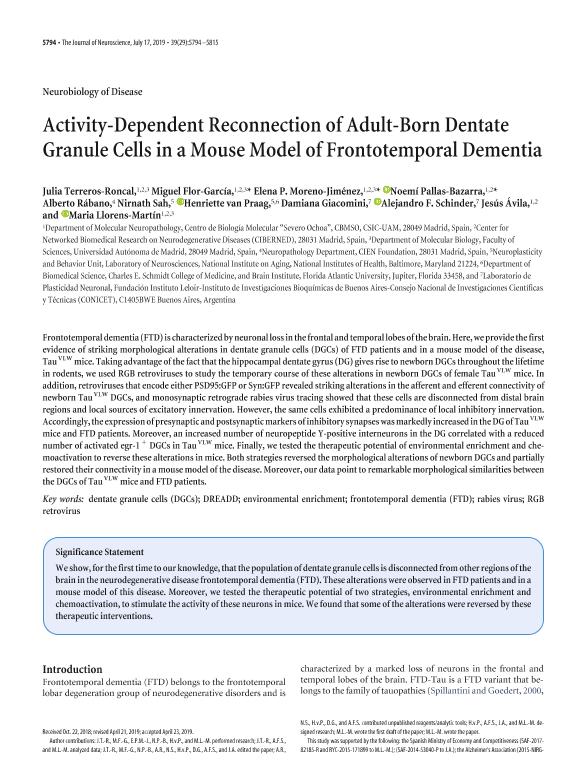Mostrar el registro sencillo del ítem
dc.contributor.author
Terreros Roncal, Julia
dc.contributor.author
Flor García, Miguel
dc.contributor.author
Moreno Jiménez, Elena P.
dc.contributor.author
Pallas Bazarra, Noemí
dc.contributor.author
Rábano, Alberto
dc.contributor.author
Sah, Nirnath
dc.contributor.author
Van Praag, Henriette
dc.contributor.author
Giacomini, Damiana Paula

dc.contributor.author
Schinder, Alejandro Fabián

dc.contributor.author
Ávila, Jesús
dc.contributor.author
Llorens Martín, Maria
dc.date.available
2021-06-11T12:45:26Z
dc.date.issued
2019-05
dc.identifier.citation
Terreros Roncal, Julia; Flor García, Miguel; Moreno Jiménez, Elena P.; Pallas Bazarra, Noemí; Rábano, Alberto; et al.; Activity-Dependent Reconnection of Adult-Born Dentate Granule Cells in a Mouse Model of Frontotemporal Dementia; Society for Neuroscience; Journal of Neuroscience; 39; 29; 5-2019; 5794-5815
dc.identifier.issn
0270-6474
dc.identifier.uri
http://hdl.handle.net/11336/133663
dc.description.abstract
Frontotemporal dementia (FTD) is characterized by neuronal loss in the frontal and temporal lobes of the brain. Here, we provide the first evidence of striking morphological alterations in dentate granule cells (DGCs) of FTD patients and in a mouse model of the disease, Tau VLW mice. Taking advantage of the fact that the hippocampal dentate gyrus (DG) gives rise to newborn DGCs throughout the lifetime in rodents, we used RGB retroviruses to study the temporary course of these alterations in newborn DGCs of female Tau VLW mice. In addition, retroviruses that encode either PSD95:GFP or Syn:GFP revealed striking alterations in the afferent and efferent connectivity of newborn Tau VLW DGCs, and monosynaptic retrograde rabies virus tracing showed that these cells are disconnected from distal brain regions and local sources of excitatory innervation. However, the same cells exhibited a predominance of local inhibitory innervation. Accordingly, the expression of presynaptic and postsynaptic markers of inhibitory synapses was markedly increased in the DG of Tau VLW mice and FTD patients. Moreover, an increased number of neuropeptide Y-positive interneurons in the DG correlated with a reduced number of activated egr-1 + DGCs in Tau VLW mice. Finally, we tested the therapeutic potential of environmental enrichment and chemoactivation to reverse these alterations in mice. Both strategies reversed the morphological alterations of newborn DGCs and partially restored their connectivity in a mouse model of the disease. Moreover, our data point to remarkable morphological similarities between the DGCs of Tau VLW mice and FTD patients.
dc.format
application/pdf
dc.language.iso
eng
dc.publisher
Society for Neuroscience

dc.rights
info:eu-repo/semantics/openAccess
dc.rights.uri
https://creativecommons.org/licenses/by-nc-sa/2.5/ar/
dc.subject
DENTATE GRANULE CELLS (DGCS)
dc.subject
DREADD
dc.subject
ENVIRONMENTAL ENRICHMENT
dc.subject
FRONTOTEMPORAL DEMENTIA (FTD)
dc.subject
RABIES VIRUS
dc.subject
RGB RETROVIRUS
dc.subject.classification
Otras Ciencias Médicas

dc.subject.classification
Otras Ciencias Médicas

dc.subject.classification
CIENCIAS MÉDICAS Y DE LA SALUD

dc.title
Activity-Dependent Reconnection of Adult-Born Dentate Granule Cells in a Mouse Model of Frontotemporal Dementia
dc.type
info:eu-repo/semantics/article
dc.type
info:ar-repo/semantics/artículo
dc.type
info:eu-repo/semantics/publishedVersion
dc.date.updated
2020-06-23T15:11:50Z
dc.identifier.eissn
1529-2401
dc.journal.volume
39
dc.journal.number
29
dc.journal.pagination
5794-5815
dc.journal.pais
Estados Unidos

dc.journal.ciudad
Washington
dc.description.fil
Fil: Terreros Roncal, Julia. Universidad Autónoma de Madrid. Facultad de Ciencias; España
dc.description.fil
Fil: Flor García, Miguel. Universidad Autónoma de Madrid. Facultad de Ciencias; España
dc.description.fil
Fil: Moreno Jiménez, Elena P.. Universidad Autónoma de Madrid. Facultad de Ciencias; España
dc.description.fil
Fil: Pallas Bazarra, Noemí. Universidad Autónoma de Madrid. Facultad de Ciencias; España
dc.description.fil
Fil: Rábano, Alberto. No especifíca;
dc.description.fil
Fil: Sah, Nirnath. National Institutes of Health; Estados Unidos
dc.description.fil
Fil: Van Praag, Henriette. National Institutes of Health; Estados Unidos
dc.description.fil
Fil: Giacomini, Damiana Paula. Consejo Nacional de Investigaciones Científicas y Técnicas. Oficina de Coordinación Administrativa Parque Centenario. Instituto de Investigaciones Bioquímicas de Buenos Aires. Fundación Instituto Leloir. Instituto de Investigaciones Bioquímicas de Buenos Aires; Argentina
dc.description.fil
Fil: Schinder, Alejandro Fabián. Consejo Nacional de Investigaciones Científicas y Técnicas. Oficina de Coordinación Administrativa Parque Centenario. Instituto de Investigaciones Bioquímicas de Buenos Aires. Fundación Instituto Leloir. Instituto de Investigaciones Bioquímicas de Buenos Aires; Argentina
dc.description.fil
Fil: Ávila, Jesús. Universidad Autónoma de Madrid. Facultad de Ciencias; España
dc.description.fil
Fil: Llorens Martín, Maria. Universidad Autónoma de Madrid. Facultad de Ciencias; España
dc.journal.title
Journal of Neuroscience

dc.relation.alternativeid
info:eu-repo/semantics/altIdentifier/doi/http://dx.doi.org/10.1523/JNEUROSCI.2724-18.2019
dc.relation.alternativeid
info:eu-repo/semantics/altIdentifier/url/https://www.jneurosci.org/content/39/29/5794.long
Archivos asociados
